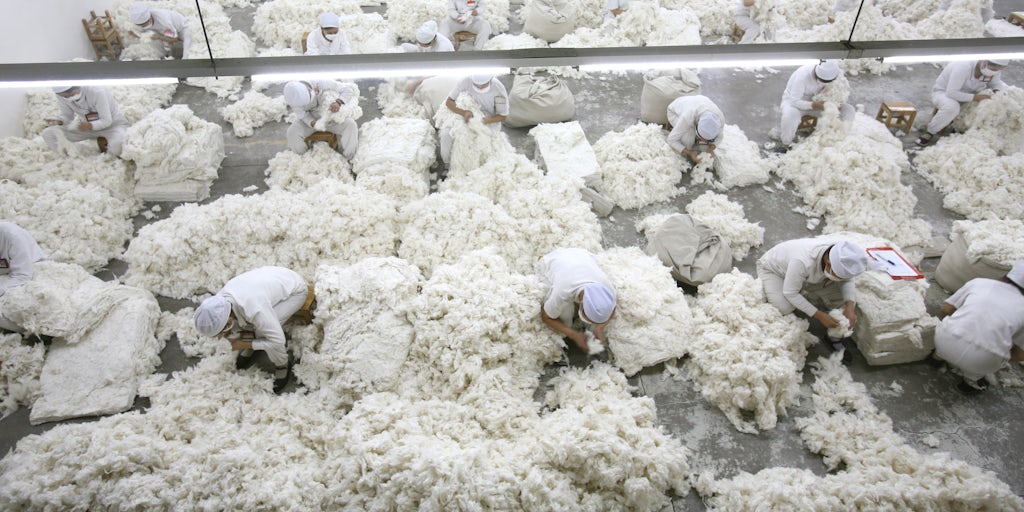What the Latest Clampdown on Xinjiang Cotton Means for Fashion | BoF Professional, News & Analysis
It’s an open secret the fashion industry has all but sidestepped for over two years, but now, widespread reports of forced labour violating the rights of Uighur Muslims and other minorities in China have culminated in the introduction of new policies from governments on both sides of the Atlantic.
Last week, the United States Customs Border Patrol (CBP) ordered a sweeping ban on products containing cotton sourced from the Xinjiang Uyghur Autonomous Region of China. Prior to this order, the US Department of Commerce blacklisted a handful of Xinjiang-based companies and a paramilitary group called the Xinjiang Production and Construction Corps, resulting in the seizure of 43 shipments of garments worth upwards of $2 million dollars from the CBP. Now, the new blanket ban on cotton products from the region is predicted to halt the import of over 1.5 billion pieces annually with a retail value of over $20 billion, according to estimates by the Workers’ Rights Consortium (WRC), an organisation that monitors labour rights.
The US ban on Xinjiang cotton “creates a situation where it is no longer feasible for any competently managed brand or retailer to see sourcing from Xinjiang as a viable strategy … unless they’re willing to take an enormous risk, not just reputationally but legally,” said Scott Nova, executive director of the Workers’ Rights Consortium. According to Nova, companies and individual executives could be prosecuted, “if it is shown that the company imported goods made with forced labour and if it is the conclusion of the prosecutors and jury that the executive should have known [about it].”
In a similar — albeit less stringent — move, the UK Government said it will review export controls out of Xinjiang and introduce fines for businesses that fail to publish modern slavery statements, in line with the 2015 Modern Slavery Act. However, it is worth noting that transparency provisions under this Act are only required of businesses with an annual turnover of at least £36 million.
Some experts interpret the latest developments as more of a diplomatic statement than highly enforceable industry regulation. “I see these pieces of legislation as political signals to China,” said Sarah Ditty, global policy director of Fashion Revolution, a non-profit that campaigns for a fairer and more transparent industry. “Both legislations will potentially catch some products … Those cases will be used as examples and certainly stimulate companies to do more,” she added, and in that sense, the measures are useful and influential.
It is no longer feasible for any competently managed brand or retailer to see sourcing from Xinjiang as a viable strategy … unless they’re willing to take an enormous risk.
Measures have been less clear-cut in other key western fashion markets. While Canada joined the UK in taking steps to prohibit imports from Xinjiang, the European Union has come under criticism by campaigners (and even the incoming Biden administration, according to Bloomberg reports) in late December for closing a deal to further open up the Chinese market to EU investment, despite previously condemning China over its human rights record and alleged mistreatment of Uighurs.
Navigating a serious supply chain disruption
Since 2018, reports have emerged that in the Xinjiang region, ethnic minorities — in particular, the predominantly Muslim Uighur ethnic group — have been subjected to human rights abuses including internment, mass sterilisation, debt bondage and forced labour. Beijing has denied these allegations, instead claiming that they are educational institutions and vocational training centres that upskill the population and crack down on extremist ideologies through cultural assimilation. However, a United Nations human rights panel said in August 2018 that it received credible reports of one million Uighurs in China being held in what appears to be a “massive internment camp that is shrouded in secrecy.”
With the new US and UK measures coming swiftly into effect, any company selling product in the US or UK faces an imminent call to rid their supply chains of Xinjiang-produced cotton, or at least provide evidence that they have done everything in their power to ensure contractors and subcontractors further along the supply chain are not sourcing materials from the region.
However, these legislative changes, particularly those in the US, pose a significant challenge to the fashion industry and underscore how little brands know about where their products originate across increasingly complex global supply chains. As much as one-fifth of the world’s cotton, the industry’s second-most-used textile after polyester, can be traced back to the Chinese region. In past months, mounting scrutiny from consumers, regulators and the media has pushed brands to issue statements on their involvement in Xinjiang. As BoF has previously reported, companies including Nike, Inditex, Lacoste and luxury giant Kering have all denounced forced labour but been unable to guarantee that their suppliers do not include facilities in Xinjiang.
LVMH said it has “a strict policy regarding its sourcing and all our direct and indirect suppliers have to apply to our code of conducts that of course bans all forms of illegal, forced or child labour as well as slavery or human trafficking,” in a statement emailed to BoF on December 16. However, the luxury conglomerate declined to disclose how much of its cotton comes from China or Xinjiang, stating it buys fabrics that are mostly made with Better Cotton Initiative (BCI) or Global Organic Textile Standard (GOTS) certified fibres, “and sourced mainly from India, USA, Egypt or Turkey.”
The list of global brands cited in reports by campaign and investigative groups total in the dozens. The problem extends beyond Xinjiang, too: a March 2020 report by the Australian Strategic Policy Institute, a think tank, identified 82 companies “potentially directly or indirectly benefiting from the use of [Uighur] workers outside Xinjiang through abusive labour transfer programmes as recently as 2019.”
Campaigners blame ‘apathetic’ fashion industry
Tracing and policing the provenance of materials down to a provincial — rather than national — level will require a level of granular detail the fashion industry is unaccustomed to and builds on the growing imperative for companies to get to grips with all the suppliers and middlemen involved in making their products. “Without that traceability, it’s impossible to know,” said Ditty. Financially incentivising known suppliers to disclose the previous link in the supply chain is one option, but as Ditty notes, expecting accountability from outsourced companies in this way is “passing the buck on to other entities.”
For the fashion industry, which by and large has been slow and reluctant to get to grips with its own, multi-tiered supply chain, this is no small feat. The production of raw materials like cotton, typically referred to as tier 4, represents the most distant stage of the complex, opaque and globe-spanning web of outsourced and sub-contracted facilities that make up a typical apparel supply chain. In fact, the majority of the world’s biggest fashion companies have only successfully identified and disclosed all suppliers at the tier 1 garment assembly level, and a select number of strategic suppliers at the tier 2 textile dyeing and processing level.
Without that traceability, it’s impossible to know.
Though they acknowledge the complexity of global manufacturing, labour rights and sustainability advocacy groups argue that the industry’s failure to fully trace its supply chain is due to apathy, not inability. “The paper trail is absolutely there,” said Nova; an active willingness to find it, however, is another matter.
But advocates of manufacturers in China suggest that the new blanket ban on the Xinjiang region is a blunt instrument that also cuts off the facilities that are not complicit in forced labour, in a region that supplied the bulk of China’s cotton long before allegations of internment and rights abuses surfaced.
Traceability solutions need investment and commitment
Even widely recognised standards for sustainable material certifications, some of which fashion brands have a tendency to align themselves with in lieu of proprietary monitoring and due diligence, are no guarantee of a supply chain free of forced labour. “China is the second-largest producer of organic cotton and most of that is from the Uighur regions,” said Nova, “so consumers who assume that if they’re buying an organic product that [it] is not tainted by forced labour from the Uighur region are making a mistake.”
The Better Cotton Initiative, which promotes more sustainable cotton farming through its Better Cotton Standard System, has also faced challenges in the past, having had certified suppliers in the Xinjiang region as recently as last year. In March 2020, BCI suspended licensing and assurance activities in Xinjiang, and in October ceased all field activity “due to the identification of clear risks and drivers of forced labour on farm level, combined with the worsening state of the operating environment,” the organisation said in a written statement to BoF.
For brands looking to ensure their supply chains are not implicated in the region, there is tracking technology available in the form of blockchain, RFID and DNA tagging, the latter of which can help identify the physical attributes of a product’s raw materials including some degree of geographical origin. But these tools don’t come cheap, and although the technology is mature, it is still in the early stages of small-scale piloting and uptake by fashion companies, said Ditty. What’s more, “to make use of these technologies, companies still need systems in place to implement them.”
Outsourcing due diligence to service providers could be a short-term solution affording companies some degree of assurance. For a monthly fee, supply chain specialist SourceMap is already advertising a Xinjiang-specific due diligence solution that “can be deployed in less than 24 hours and implemented across a global supply chain within four weeks.”
WRC’s Nova and Fashion Revolution’s Ditty recommend signing a call to action established by The Coalition to End Forced Labour in the Uyghur Region, an alliance of NGOs, civil society and trade union organisations, which holds signatories accountable by independently verifying their due diligence efforts. Some companies, including British retailer Marks and Spencer, have publicly signed the commitment, while others have done so privately citing concern for the risk to the safety of personnel elsewhere in their Chinese supply chain, or fears that public endorsement will negatively impact commercial interests in China as a consumer market, but “we will not allow them to be private [signatories] indefinitely,” said Nova.
According to campaigners, ultimately the imperative for brands to extricate themselves from Xinjiang is about more than pre-empting reputational or legal risk. “These are really urgent issues,” said Ditty. “Lives are at stake.”
Related Articles:
Is Forced Uighur Labour in Your Supply Chain?
Are These Fashions Linked to Forced Labour? Brands Can’t Confidently Say No.
How Likely Is It to Find Slavery in Fashion’s Supply Chains? Very.



:quality(70)/cloudfront-eu-central-1.images.arcpublishing.com/businessoffashion/MXZ72DK3CVBQVMXMU6PLMPVCBU.jpg)

